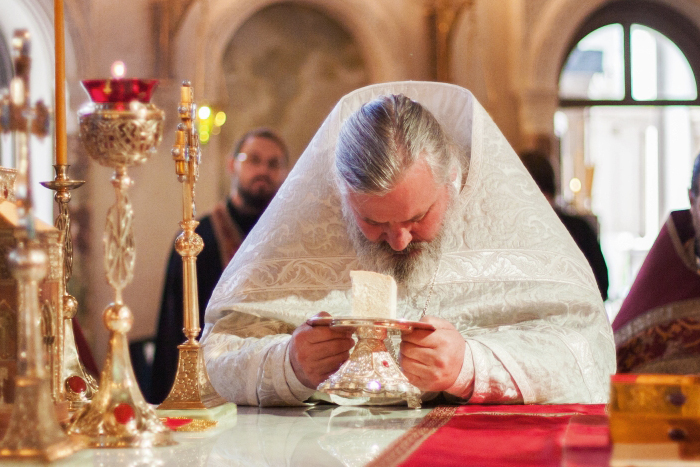
When a priest is being ordained, the bishop hands over to him the so-called Pledge (Greek: παρακαταθήκη), a particle of the Body of Christ. This term has sometimes been used in Byzantine liturgical terminology to refer to the Holy Gifts. The priest must hold this Pledge with fear and trembling, reflecting on the great responsibility that now rests upon him as a presbyter. When and why did this tradition emerge in the Church? What is its meaning in the Orthodox worship?
The modern tradition prescribes to give the Pledge to the newly-ordained priest after the consecration of the Gifts; in the Russian tradition it happens immediately after bread and wine are changed in the Body and Blood of Christ before the words “to be the partakers”, whereas in the Greek practice it comes after the end of the intercession for the saints before the words “first remember the Lord”. Having put a part of the consecrated Gifts on a separate diskos, the bishop give it to the person being ordained into priesthood with the following words, “Take this pledge and keep it safe and sound until thy last breath, for thou shalt be tried in the Second and Terrible Coming of the Great Lord God and Our Savior Jesus Christ” (Archieratikon). While holding the diskos with the consecrated Bread in his hands, the priest must read Psalm 51, as well as various penitential troparia of his choice until the call Holy things to the holy. Finally, the Pledge is returned to the rest of the Holy Gifts for breaking and communion. What is the meaning of this liturgical practice?
The Byzantine practice reveals the original meaning of the Pledge. The Pledge in the Byzantine Church was given to the candidate not after the consecration of the Holy Gifts but rather before the consecration, with the implication that the newly-ordained priest would immediately start doing his chief sacred duty, which was the reason for his ordination, namely the celebration of the Holy Eucharist. This order was fully consistent with other rituals of initiation into ecclesiastical and sacred ranks: a singer received a Psalter and he was to sing a prokeimenon; a reader received the Epistle and was to read an extract from it; a deacon would receive a fan to wave over the Gifts and the Chalice to distribute the Blood to the people (this practice was later canceled). After his ordination, the new bishop took the place of the presiding bishop (in modern practice, the new bishop does not take the place of the presiding bishop, but the custom of his saying the previously first call of the chief celebrant at the Liturgy – Peace to all before the reading of the Epistle – has been preserved). It was with this liturgical logic in mind that a separate Lamb, prepared in advance at the proskomedia, was given to the newly-ordained priest. The new presbyter co-officiated the Liturgy with his bishop, read the Anaphora with him, and thus consecrated the Bread for the first time (Archpriest Alexander Z. Neselovsky, Rites of Cheirotonia and Cheirotesia). Why does the current Typikon prescribe giving the priest a piece of already consecrated Bread as the pledge?
The Typikon was changed in the 15th century, which could be due to two reasons. One is that the priest receiving the already consecrated Pledge was a reaction to certain features of the Latin worship. Saint Symeon of Thessalonica asserts the superiority of the Byzantine tradition of handing to the priest of a Consecrated Pledge over the Western tradition of anointing the hands of the newly-ordained priest with holy oil (Sym. Thessal. De sacris ordinationibus. 183 // PG. 155. Col. 392). This is how the bishop of Thessalonica explains the new practice: this ceremony is filled with all kinds of fear for it shows that [the presbyter] becomes a steward of the Mysteries of God and accepts for his ministry nothing other than the living Bread – Jesus, and therefore the newly-ordained priest must take care of it, namely priesthood, and keep himself impeccable for that is what the Lord will seek of him (Sym. Thessal. De sacris ordinationibus. 182 // PG. 155. Col. 389-392).
The second reason for changing the practice was that when the newly-ordained priest had been given the Lamb to be consecrated at the same time with the Eucharist that the bishop had been celebrating with the main Lamb, people could imagine that there were two Liturgies celebrated on one Holy Table simultaneously. The Church deemed it unacceptable and contrary to the holy canons, which led to the current regulations. The Russian tradition follows the Order of Divine Liturgies compiled by Saint Athanasius the Wonderworker of Constantinople and Kharkov (†1654), according to which the part of the Consecrated Lamb with the letters XC (Christus) on it is used as the Pledge. The Greek Church, however, has maintained the ancient custom to select a special Lamb, which is prepared at the proskomedia in advance, following the provisions of the 1276 Lesser Synod of Constantinople, which banished the handing out of the Holy Bread until the very moment of the dissection of the Holy Gifts (Bishop Porphyrius (Uspensky), The First Journey to the Monasteries and Sketes of Mount Athos).
So, the meaning of giving the Pledge was that the priest would immediately begin the main sacramental action of his priestly ministry. After the change in the Typikon, this meaning has not changed much – the presbyter is entrusted with Christ Himself; he holds the Body of the Creator of the Universe in his hands and is the housekeeper of God’s Mysteries. This is the greatest responsibility to which not only priests but also the laics are called, since each of us receives the Body and the Blood of Christ in the Eucharist. The lives of our families and our own eternal fate depends on how we deal with this Gift.



